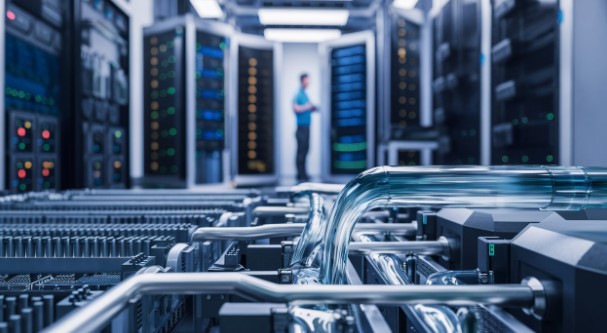What Are the Benefits of Liquid Cooling for Data Centers?

Introduction to Data Center Cooling
In the rapidly evolving world of data centers and hosting services, efficient cooling systems play a crucial role in maintaining optimal performance and reliability. As technology progresses and server densities rise, conventional air-based thermal management methods are facing challenges from innovative liquid-based solutions. This article explores the various temperature control technologies employed in data centers, comparing liquid and air-based approaches, and examining the future landscape of thermal management in these facilities.
Understanding Air Cooling in Data Centers
Air cooling has been the standard method for temperature control in data centers for decades. This approach typically involves using air conditioning units to circulate cool air throughout the facility, removing heat generated by servers and other equipment.
Key Components of Air Cooling Systems:
- Computer Room Air Conditioning (CRAC) units
- Raised floors for air distribution
- Hot and cold aisle configurations
- Air handlers and chillers
Although air-based thermal management is well-established and relatively straightforward to implement, it struggles to meet the heat dissipation requirements of high-density server racks. Moreover, this traditional approach often falls short in energy efficiency when compared to more advanced thermal control technologies.
The Rise of Liquid Cooling in Data Centers
Liquid cooling has gained significant attention in recent years due to its superior heat transfer capabilities and potential for improved energy efficiency. This method involves using a liquid medium, such as water or specialized coolants, to remove heat from server components.
Types of Liquid Cooling Solutions:
- Direct-to-chip thermal management
- Immersion-based heat dissipation
- Rear-door heat exchangers
- Cold plate technology
Each of these methods offers unique advantages in terms of thermal efficiency and implementation flexibility, catering to diverse data center requirements and constraints.
Comparing Liquid and Air Cooling Efficiency
When assessing thermal management solutions for data centers, efficiency stands as a critical factor. Liquid-based systems generally offer several advantages over traditional air-based approaches:
- Higher heat transfer capacity
- Reduced energy consumption
- Better performance in high-density environments
- Potential for heat reuse in other applications
However, the decision between liquid and air cooling is not always straightforward. Factors such as initial investment costs, infrastructure requirements, and maintenance considerations must be carefully weighed.
Innovative Cooling Technologies in Modern Data Centers
As data centers evolve, so do their thermal management technologies. Some cutting-edge methods include:
1. Two-Phase Immersion Heat Dissipation
This technology submerges servers in a dielectric fluid that boils at a low temperature, efficiently removing heat through the phase change process.
2. Evaporative Temperature Control
Utilizing the natural heat reduction effect of water evaporation, this method can significantly lower energy consumption in suitable climates.
3. Geothermal Climate Control
By leveraging the constant temperature of the earth, geothermal systems can provide efficient thermal management with minimal environmental impact.
4. AI-Driven Thermal Optimization
Advanced algorithms and machine learning are being employed to dynamically adjust temperature control systems for maximum efficiency.
Liquid Usage in Data Center Cooling
In data center thermal management, water is commonly utilized for heat dissipation, but it’s not the sole option. The selection of liquid for temperature control depends on the specific system and requirements of the facility. Let’s explore the various fluids employed in modern data center thermal solutions.
Types of Liquids Used in Data Center Thermal Management:
- Water: Most widely used in traditional chilled water systems and heat exchange towers
- Dielectric fluids: Non-conductive liquids used in immersion-based heat removal
- Refrigerants: Applied in some direct-to-chip thermal solutions
- Mineral oil: An alternative for immersion-based heat dissipation
While water remains a popular choice due to its availability and heat transfer properties, many data centers are exploring alternative liquids to enhance thermal efficiency and reduce environmental impact. For instance, some facilities use engineered fluids that offer better thermal conductivity and lower electrical conductivity than water, making them safer for direct contact with electronic components. The selection of heat transfer medium often depends on factors such as thermal efficiency, safety, cost, and environmental considerations.
Choosing the Right Cooling Solution for Your Data Center
Selecting the optimal cooling technology for a data center involves considering multiple factors:
- Server density and heat output
- Geographic location and climate
- Energy efficiency goals
- Available infrastructure and resources
- Long-term scalability requirements
For hosting providers and colocation facilities, the choice of cooling technology can significantly impact operational costs and service reliability.
The Future of Data Center Cooling
As data centers continue to grow in size and importance, the evolution of cooling technologies is expected to accelerate. Future trends may include:
- Increased adoption of hybrid cooling solutions
- Development of more efficient and environmentally friendly coolants
- Greater integration of renewable energy sources in cooling systems
- Advancements in heat recovery and reuse technologies
These innovations will play a crucial role in supporting the expanding digital infrastructure while minimizing environmental impact.
Conclusion
The landscape of data center thermal management is rapidly evolving, with liquid-based solutions emerging as a formidable alternative to traditional air-based methods. While air-based systems remain prevalent, the benefits of liquid-based approaches in terms of efficiency and performance are driving their adoption in many modern data centers. As the industry continues to innovate, a diverse range of cooling technologies is being developed to meet the unique needs of different hosting environments. By staying informed about these advancements, data center operators and hosting providers can make informed decisions to optimize their cooling strategies, ensuring reliable and efficient operations in the face of growing computational demands.

